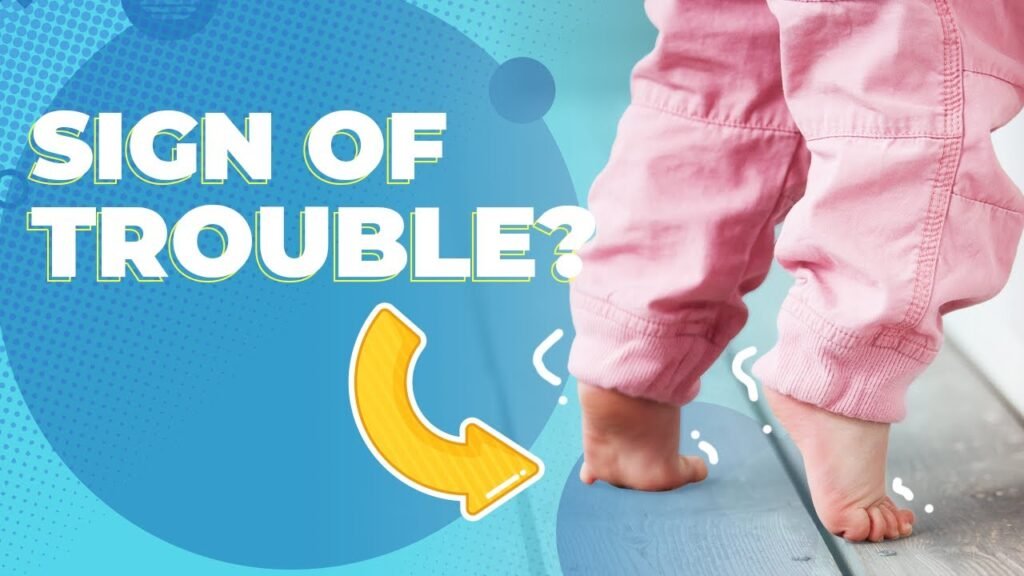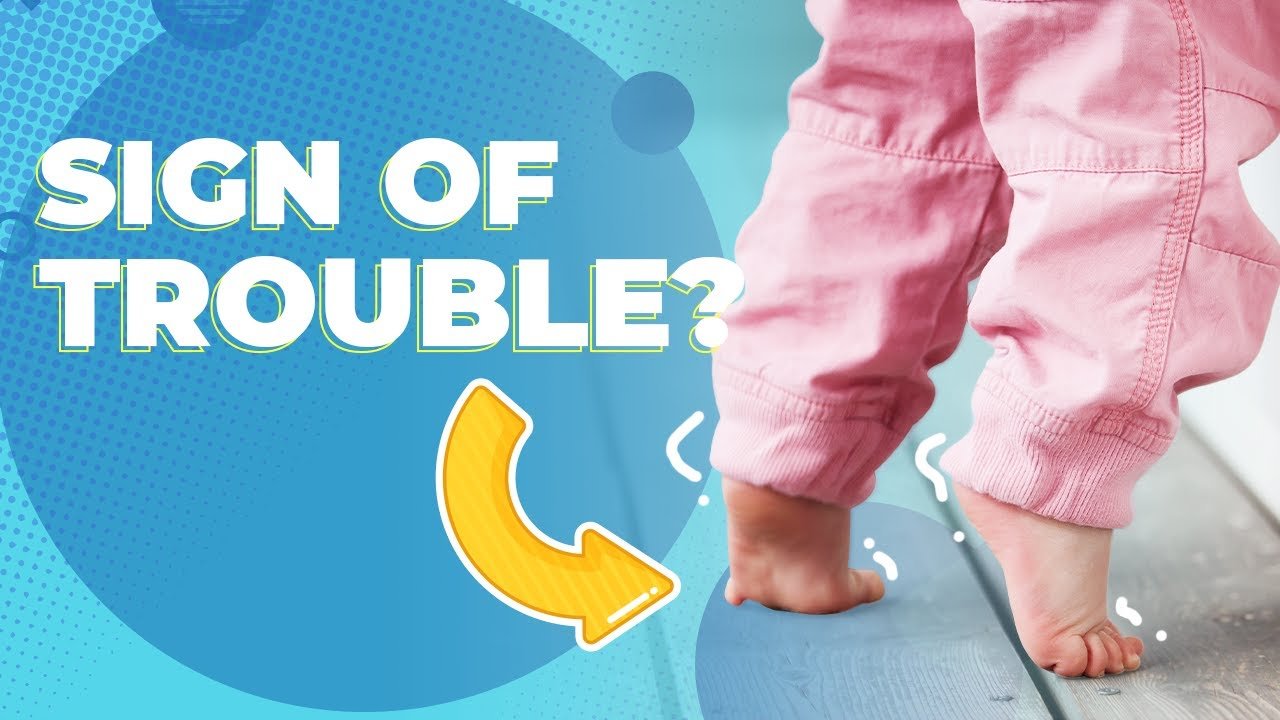When toddlers first start walking, we see their feet doing really funny things. So they might be walking on their toes, their feet might be turned in, they might have really flat feet, plus many more things. And when we see this, we might actually get concerned that there is something wrong. Some of these behaviors are completely normal, but there are points where you do need to be concerned. In this video, the age your baby will be when you can see these different walking styles will be walked through.
Parents often comment on their child’s walking habits, such as toe walking, flat feet, pigeon toes, or bowed legs. These behaviors can be normal in children, but there are situations where seeking professional advice is important. This video by Emma Hubbard provides valuable information on how to differentiate between normal and concerning walking styles, ensuring that parents have the knowledge to address any potential issues early on.

Toe Walking (Walking on Tippy Toes)
When babies and toddlers start to walk, it is common to see them walking on their tippy toes. This behavior is normal under the age of two as children explore different foot postures while learning to walk. It is often seen when children are cruising along furniture that is too high or simply for fun throughout the day. However, there are specific situations when toe walking may raise concerns and prompt the need for medical advice.
If you notice your child walking on their toes more than 50% of the time or only with one foot, it is essential to consult a healthcare provider. Additionally, if your child cannot make full contact with their feet on the ground when standing or if toe walking affects their ability to move around, seeking medical advice is recommended. Monitoring your child’s toe walking habits and observing any impact on their mobility can help determine when it is necessary to consult a doctor for further evaluation.
Flat Feet
Flat feet are common in children when they first start walking due to the flexibility of their bones and ligaments, as well as the presence of a fat pad in the foot that hides the arch. Typically, children develop an arch in their foot around three to six years of age as their muscles and ligaments strengthen. Most children with flat feet do not experience pain or require orthotics for support.
However, if your child complains of foot pain, limps while walking, or displays stiffness in the foot, it may be necessary to seek medical advice. Limited movement in the ankle or persistent discomfort could indicate an underlying issue that requires evaluation by a healthcare professional. Monitoring your child’s comfort level and mobility can help determine if further medical attention is needed.
Feet are Turning In (Pigeon Toed)
When children walk with their feet turned in, also known as in-toeing or pigeon toes, it can be caused by the rotation of the thighbone, shinbone, or part of the feet. In most cases, this foot posture corrects itself over time as the bones straighten and align naturally. However, if your child experiences a limp, complains of leg or hip pain, or if the in-toeing worsens over time, it is advisable to seek medical advice.
Monitoring your child’s gait and any discomfort they may experience while walking can help determine when to consult a healthcare provider for further assessment. Paying attention to any changes in their walking pattern or complaints of pain can guide you in deciding when professional guidance is necessary.
Bowed Legs
Bowed legs are characterized by a noticeable gap between the knees and lower legs when a child stands with their feet together. This condition is typically due to the outward curvature of one or both legs and is common in children who are learning to walk. Most children outgrow bowed legs by the age of one and a half to two years without any impact on their walking abilities.
If you observe severe bowing of the legs, one leg being more bowed than the other, or if your child walks with a limp or experiences pain, it is important to seek medical attention. Consulting a healthcare provider can help determine if there is an underlying cause for the bowing legs and ensure proper management if needed.
Importance of Early Detection
Early detection of abnormal foot postures in children is crucial in preventing future complications and addressing any underlying issues promptly. Parents play a vital role in monitoring their child’s walking patterns and seeking professional advice when necessary. By being proactive in recognizing warning signs and seeking timely intervention, parents can help promote healthy foot development in their children.
Regular check-ups and follow-ups with healthcare providers can help track your child’s progress and address any concerns that may arise. Seeking professional advice early on can lead to better outcomes and minimize the risk of long-term implications related to untreated foot postures.
Consulting a Healthcare Professional
When it comes to addressing foot concerns in children, choosing the right healthcare provider is essential. Consulting a pediatrician, orthopedic specialist, or podiatrist can provide valuable insight into your child’s foot development and any potential issues. Regular check-ups and follow-up appointments can help monitor progress and ensure appropriate interventions are implemented if needed.
Addressing concerns and seeking guidance from a healthcare professional can alleviate any worries you may have about your child’s foot health. By establishing a collaborative relationship with a trusted provider, you can work together to address any foot-related issues and promote optimal foot development in your child.
Risk Factors and Complications
Untreated foot postures in children can lead to potential risks and long-term implications if ignored. Inadequate foot support or alignment can affect a child’s mobility, coordination, and overall foot health. By recognizing warning signs and seeking medical advice, parents can help prevent complications and ensure their child receives appropriate care.
Support and resources are available for parents to access information, guidance, and interventions to address foot concerns in children. By being proactive in monitoring foot health and seeking professional advice, parents can help mitigate risks and support healthy foot development in their children.
Parental Support and Guidance
Creating a supportive environment for children with foot concerns is important for their overall well-being. Encouraging physical activity, promoting healthy habits, and providing appropriate footwear can help support proper foot development. Educating family members and caregivers about the importance of foot care and monitoring can create a united front in ensuring your child’s foot health.
By fostering an environment that values foot health and encourages proactive measures, parents can instill good habits in their children and promote lifelong foot wellness. Offering support, guidance, and resources to address foot concerns can empower parents to take an active role in promoting optimal foot development in their children.
Educational Resources and Tools
Online resources and guides are available for parents seeking information on child foot development and related concerns. Interactive tools designed to track developmental milestones can help parents monitor their child’s progress and identify any deviations early on. Recommended reading materials and websites offer further information and insight into promoting healthy foot development in children.
Accessing educational resources and tools can provide parents with valuable information and guidance on monitoring their child’s foot health. By utilizing these resources, parents can equip themselves with the knowledge and tools needed to support optimal foot development and address any concerns that may arise.
Conclusion
In conclusion, being aware of common foot postures in children and knowing when to seek medical advice is crucial for promoting healthy foot development. From toe walking and flat feet to feet turning in and bowed legs, understanding the normal variations in foot posture and recognizing warning signs is essential for parents. By prioritizing early detection, consulting healthcare professionals, and providing parental support and guidance, parents can help ensure their child’s foot health is monitored and maintained.
Encouraging a proactive approach to foot care, seeking professional advice when needed, and utilizing available resources and tools can empower parents to support optimal foot development in their children. By prioritizing foot health and taking proactive measures, parents can play a significant role in promoting healthy foot development and overall well-being in their children. Remember, your child’s foot health is important, and by staying informed and proactive, you can help them put their best foot forward.

